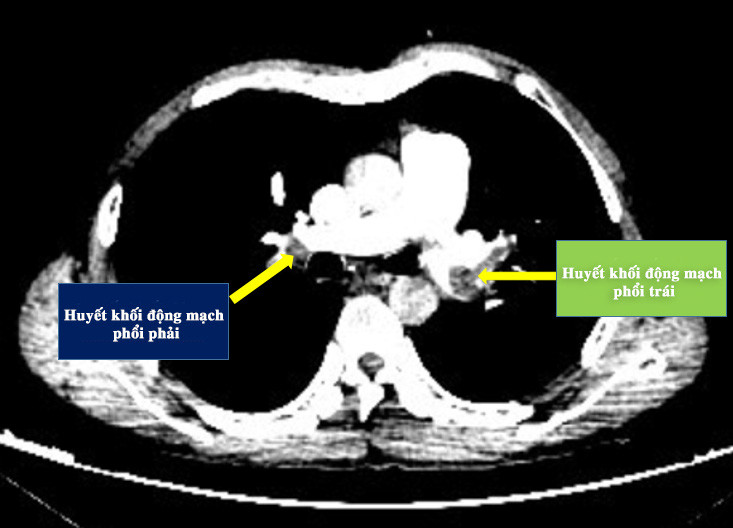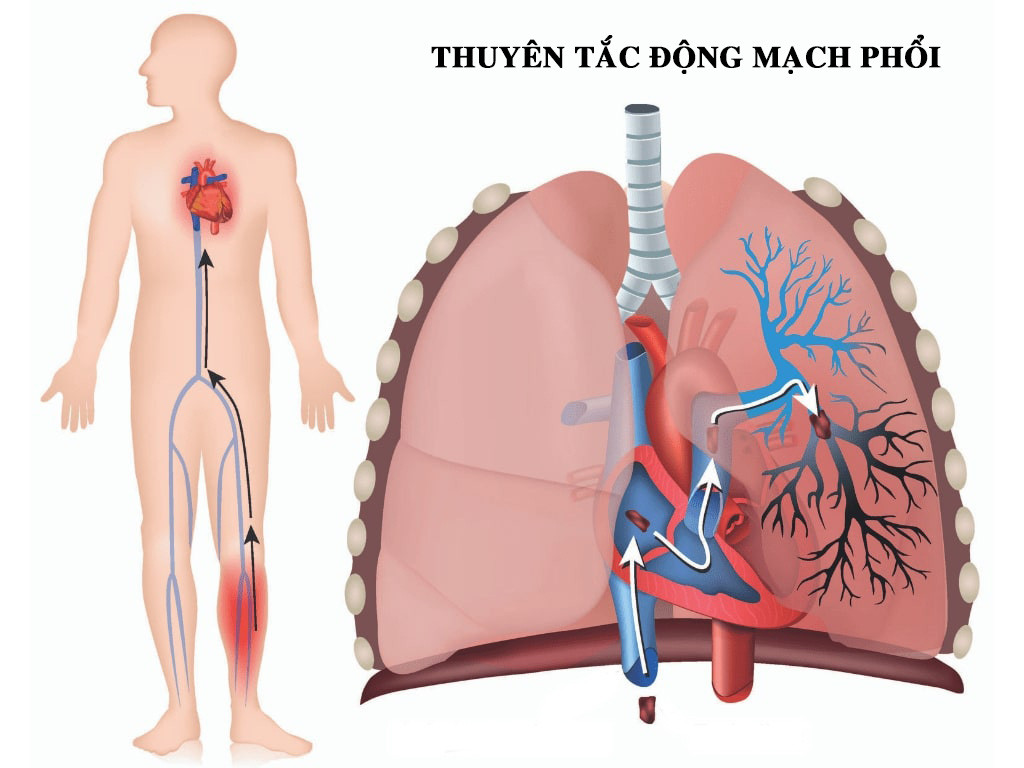Acute pulmonary embolism is considered a “hidden killer” because it can occur in anyone, but is difficult to diagnose due to confusion with other diseases. The disease progresses rapidly, and a significant proportion can be fatal.

Quang Ninh General Hospital has just consecutively treated two cases of acute pulmonary embolism occurring both inside and outside the hospital.
Patient LVB (37 years old, Hai Ha, Quang Ninh) had chest pain and difficulty breathing at home and was taken to the District Medical Center for emergency treatment in a state of low blood pressure. Medical history revealed that the patient had deep vein thrombosis of the lower extremities and was taking medication regularly.
The on-duty team quickly contacted Quang Ninh General Hospital for consultation and diagnosed suspected acute pulmonary embolism.
The patient was treated with anticoagulants and vasopressors and immediately transferred to the provincial hospital. A CT scan of the pulmonary arteries revealed bilateral pulmonary artery occlusion.

Another case is Ms. PKT (57 years old), while being treated for a cerebral hemorrhage at the hospital, she experienced respiratory failure and circulatory arrest. Immediately, the patient was successfully resuscitated with cardiopulmonary resuscitation.
Doctors urgently assessed the cause of local circulatory arrest through paraclinical results, diagnosing acute pulmonary embolism causing respiratory failure and circulatory arrest in patients with cerebral hemorrhage.
Similarly, at the 108 Central Military Hospital, a 75-year-old female patient was admitted to the hospital in a state of cardiac arrest, with unmeasurable pulse and blood pressure, 4mm dilated pupils on both sides, and negative light reflex.
According to the patient's family, an hour before entering the hospital, the patient suddenly had difficulty breathing and was taken to the emergency room. Doctors diagnosed the patient with a pulmonary embolism.
Doctor Pham Quang Trinh - emergency department, 108 Central Military Hospital - said that pulmonary embolism, commonly known as pulmonary embolism, is an extremely serious disease that often leads to death if not detected and treated promptly.
Pulmonary infarction occurs when part of the lung tissue dies because its blood supply is blocked.
Depending on its size and location, the symptoms of pulmonary embolism can vary from person to person. When pulmonary embolism occurs, the patient needs to be evaluated and treated aggressively. Although there are many quite active treatments available today, the overall mortality rate in patients with pulmonary embolism is still around 20-30%.
Pulmonary embolism is common in elderly patients with comorbidities, especially coexisting cardiovascular disease and underlying malignancy, but is rare in young and healthy individuals.
However, in recent years, the rate of pulmonary embolism in young people has been increasing, related to lifestyle such as lack of exercise, smoking, alcohol abuse, and birth control pills.
Typical signs of pulmonary embolism: Shortness of breath, difficulty breathing, chest pain, persistent cough, accompanied by blood or phlegm, heart rhythm disturbances, feeling dizzy and lightheaded, profuse sweating, fever, pain in the calves, skin discoloration, cardiogenic shock.

Doctor Ha Manh Hung - head of the intensive care unit, Quang Ninh General Hospital - said that acute pulmonary embolism is a condition of blood vessel blockage in the lungs due to blood clots, often caused by venous thrombosis in the lower extremities moving up.
The disease is not rare but difficult to diagnose because there are no specific symptoms, easily confused with other diseases. This is a serious medical emergency, sudden onset, the mortality rate can be up to 30%, so the initial diagnosis requires quickness and accuracy to provide the most appropriate and timely treatment.
Pulmonary embolism can happen suddenly to anyone, at any age. The risk is common in surgical patients, patients with limited mobility (fractures of lower limbs, in intensive care, elderly), patients with malignant diseases, patients with a history of venous thrombosis...
The clinical symptoms of pulmonary embolism are very diverse and mostly non-specific, and can appear in many different clinical situations. When pulmonary embolism is severe, the risk of death can be up to 60% with very rapid progression in the first 1 to 2 hours.
"Although pulmonary embolism is not rare, few people know about it. The disease has many different levels of manifestation. At a severe level, it can cause shock, low blood pressure, respiratory failure, and circulatory arrest. Mild symptoms include chest pain and moderate difficulty breathing, without causing shock. There are even patients who have no symptoms and are chronic for a long time without being detected.
According to statistics, about 1/3 of people with pulmonary embolism die due to delayed diagnosis and treatment. Therefore, the initial diagnosis needs to be accurate, thereby providing timely treatment, reducing the mortality rate caused by this disease," said Dr. Hung.
Risk factors for pulmonary embolism are: major surgery, prolonged immobilization, lower limb trauma, spinal trauma, obesity, advanced age, oral contraceptives, pregnancy, postpartum, cancer and cancer treatment, stroke, long-term central catheterization, pacemaker electrodes, smoking, long-distance air travel, chronic obstructive pulmonary disease...